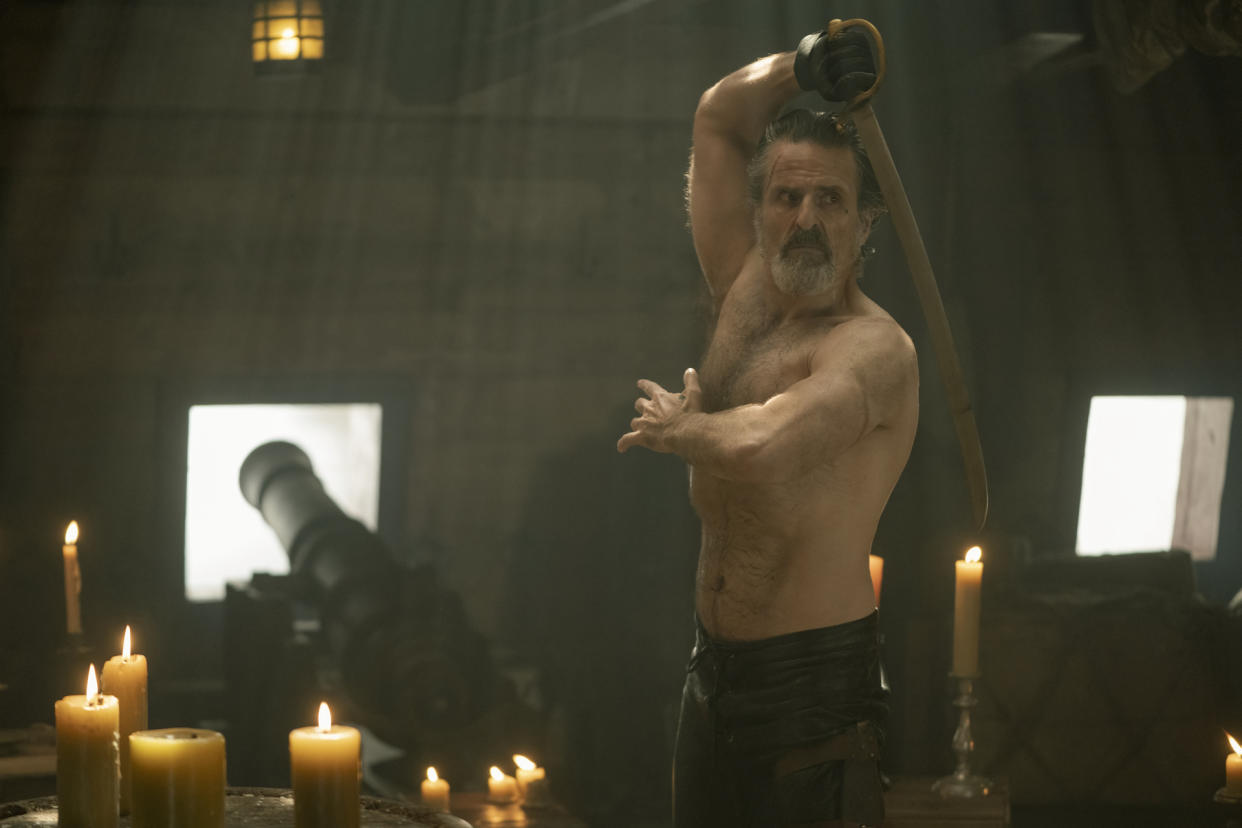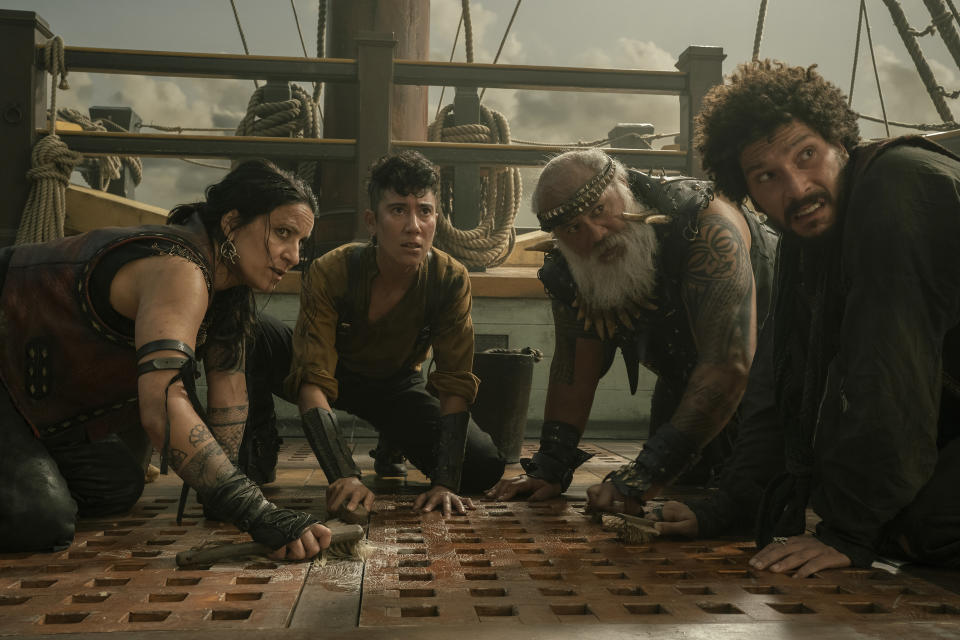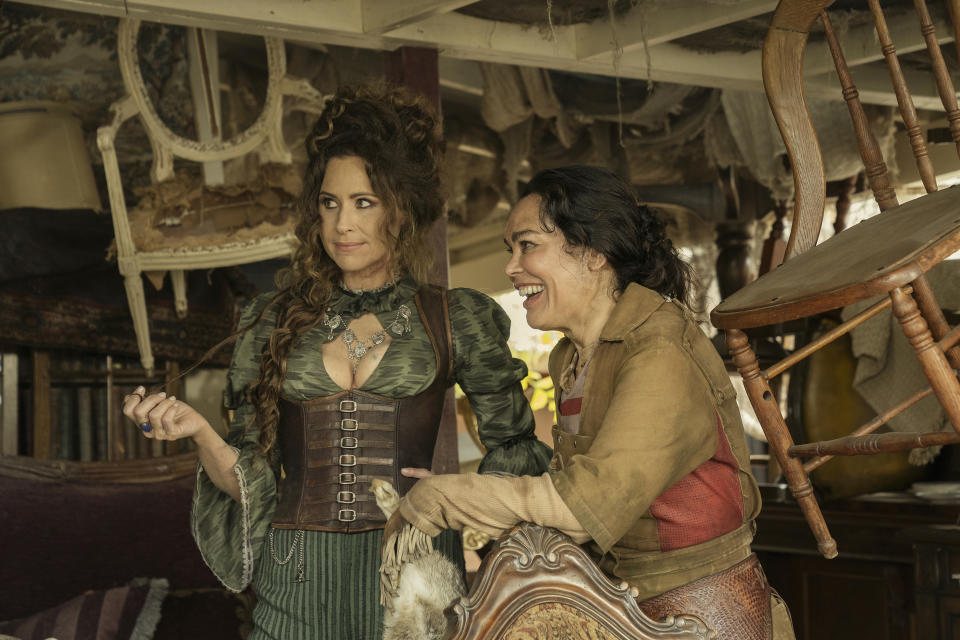David Jenkins Plundered This Trick from Taika Waititi When Directing Season 2 of ‘Our Flag Means Death’

- Oops!Something went wrong.Please try again later.
- Oops!Something went wrong.Please try again later.
- Oops!Something went wrong.Please try again later.
As the recently concluded WGA strike conclusively proved, a TV writer’s work doesn’t stop the moment they shut Final Draft. A TV showrunner all the more so. For both Season 1 and Season 2 of “Our Flag Means Death,” creator David Jenkins has had to weigh in on every facet of the series: from the biker-gang look of Blackbeard’s (Taika Waititi) crew to the comic-splash-panel style of the cinematography in romantic moments between the notorious pirate and the show’s more low-key infamous lead Stede Bonnet (Rhys Darby) to the quality of clouds brought in by the VFX team for the show’s LED background.
So while stepping into the director’s chair for the first two episodes of Season 2 did give Jenkins even more and new choices to make, he found it was a smooth transition; the work of directing honestly offered a bit of a break from thinking about the flow of the show in its entirety to focusing in on specific moments and scenes. “The only thing that’s hard is I have to prep other episodes while I’m directing. So you still have to do managerial stuff on top of it, but it’s fun. It was fun. It felt pretty natural,” Jenkins told IndieWire on the Filmmaker Toolkit podcast.
More from IndieWire
Jenkins credits the show’s other directors, including Fernando Frias, Andrew DeYoung, Bert and Bertie, Nacho Vigalondo, and Taika Waititi, with setting a great template for him in terms of the overall stylistic approach to the show’s visuals and transitions, and also with how they work on set. “I learned a lot from watching Taika,” Jenkins said. “Taika plays music [on set] and I think it’s really effective and so I do that. I stole that from him. And it’s nice to be able to play music, dial somebody into the performance, and then just be there with them.”
Some of what Jenkins would play on set ended up in the finished episode and some was just for vibes, but all his choices helped create a sense of what the overall emotional goal of a sequence was without having to break it down in weighty detail. Jenkins knew in advance, for instance, that “Run From Me” would be the knowing counterpoint to the absolute mayhem on the deck of Blackbeard’s ship in the Episode 2 storm.
“That day was a wild day because we’re trying to do an action sequence on the show which is still a half-hour comedy,” Jenkins said. “There was rain and fans and everybody was freezing. So that day you need some hollow notes to just relax everybody. Just like, ‘Hey, we’re still having fun, even though we’re torturing you.’ Anything high energy is good. I think that was a big Nicki Minaj day, too.”
Jenkins likens the process of grounding a set to the process of exploring story beats for the characters in the writers room. The writer’s job is to open themselves up to the different kinds of emotional vulnerability that a character feels when, just for example, a couple of idiots on their crew hacks off their gangrenous leg. The director does that same work along with the actors.
“You get to be the person that makes them comfortable and you get to be the person that dials them into the scene and you get to be the person that makes it feel like it’s just you and them and they can be vulnerable,” Jenkins said. “And that’s such a nice feeling. I feel like I get that experience in the writers’ room but to have that experience with the actors while we’re making something together is the best thing. It feels like what I love about the writers’ room, too.”
Creating an environment for great collaborative storytelling is something that all TV shows try to do, of course, but “Our Flag Means Death” straddles a few lines that make its sandbox a particularly fun one. The Max series continually stretches the visual limits of a half-hour comedy; it dares its crew to get as close to a fantasy show like “Game of Thrones” as it can, given the time and budget demands while also taking a more lo-fi, rule-of-funny approach to its period and fantasy elements. “The exciting thing to me about doing a really big overwrought genre piece like this in a medium where you really have to pick your shots, I think you get into more interesting corners of it that I haven’t really seen before,” Jenkins said.

The limitations of the show also naturally push it back towards moments with the ensemble and plot problems that it would frankly be irresponsible to tackle if you had a giant budget and a fully working ship-of-the-line to sail and then blow to bits. “That’s the fun of the show to us, I think. If you open this up and you’re like, unlimited budget, that would be terrible because I think you can get seduced,” Jenkins said. “[It could be like,] ‘Oh man, it’s all leading up to a climatic battle on the sea.’ And those things are great. But that’s not this show.”
The “Our Flag Means Death” creator thinks hidden corners of genre that you have to explore when dragons are off the table are also, frankly, a lot of fun to make — especially in comparison to the other genre pieces that tend to shoot in New Zealand.
“It’s a small country and it’s a small team. So a lot of people are like, ‘Oh yeah, me, I worked with James Cameron on ‘Avatar’ and now I’m doing a little pirate show. And they’re like, ‘Your show is harder because we don’t have the time and we don’t have the budget,’” Jenkins said. “The nice thing about that, though, is you get to be the lo-fi show that’s like, ‘Hey, we’re making “The Muppets.”‘”

The benefit of being smaller, fleeter, and needing all hands to come together (literally) on deck, though, is that Jenkins and the other directors can imbue the making of the show with the spirit of its absurd pirate comedy. “People feel like, ‘Oh, this is a little more laid back and fun. And we’re a little more engaged and it starts to feel like an indie even though you’re spending quite a bit of money per episode,” Jenkins said.
They are also, for both Season 1 and Season 2, burning through story. Episode 4 has already delivered on a long-held fan desire for seeing Anne Bonny (Minnie Driver) and Mary Read (Rachel House) as an even more fucked-up couple than Ed and Stede; the inclusion of Zhang Yi Sao (Rubio Quan) and a whole fleet of Chinese pirates making plans on both sides of Panama gives Season 2 even more of a sense of barely contained mayhem poised to explode in Stede’s face. “We just want to do the smaller emotional stories, but still make it feel like the world is big and dangerous and there’s all these things happening off camera,” Jenkins said.
And Jenkins doesn’t want the show to hold anything back as it continues to use its genre elements to tell relationship stories with an absurd pirate zest. “When you get to make one of these things, to me, what’s important is that it feels weird and it feels like we got to do stuff and try some things,” the “Our Flag Means Death” creator said. “Maybe you get one season. Maybe you get two… you don’t know if you’re going to be back, so try stuff. Especially when you have this large of an ensemble. Try stuff.”
Two new episodes of “Our Flag Means Death” premiere every Thursday through the finale on October 26.
Best of IndieWire
Where to Watch This Week's New Movies, from 'Anatomy of a Fall' to 'Taylor Swift: The Eras Tour'
The Best Thrillers Streaming on Netflix in October, from 'Fair Play' to 'Emily the Criminal'
Sign up for Indiewire's Newsletter. For the latest news, follow us on Facebook, Twitter, and Instagram.

